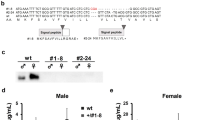Abstract
Egg production in insects is generally considered to require the availability of the yolk precursor, vitellogenin. In most insects, the synthesis of this protein in the female fat body and its uptake into the ovaries are under the control of the hormones, juvenile hormone and ecdysone1, which is somewhat analogous to the oestrogenic control in oviporous vertebrates2. Indeed, vitellogenin constitutes ∼90% of total egg proteins in the cockroach, Leucophaea maderae3, and ∼40% in the silkworm, Bombyx mori (unpublished data). However, in some insects4–9, rudimentary ovaries transplanted into male hosts are known to develop to mature eggs with chorion but lacking vitellogenin. Drosophila melanogaster is exceptional in that the ovaries themselves can produce vitellogenin, which accounts for its accumulation in ovaries transplanted into males8. Vitellogenin is believed to represent a reserve for use during embryogenesis10,11. However, experiments on D. melanogaster12 and B. mori (unpublished data) demonstrated that vitellin was not used rapidly during embryonic development and persisted at a considerable level in the newly hatched larvae. These facts suggest that vitellogenin may not be essential for ovarian development or for embryonic development. Therefore, the present experiments were carried out in order to establish whether the vitellogenin-deficient eggs that matured in male hosts, if activated by artificial parthenogenesis13, can compute embryonic and further post-embryonic development. We have found that they can.
This is a preview of subscription content, access via your institution
Access options
Subscribe to this journal
Receive 51 print issues and online access
$199.00 per year
only $3.90 per issue
Buy this article
- Purchase on Springer Link
- Instant access to full article PDF
Prices may be subject to local taxes which are calculated during checkout
Similar content being viewed by others
References
Hagedorn, H. H. & Kunkel, J. G. A. Rev. Ent. 24, 475–505 (1979).
Ryffel, G. O. Molec. cell. Endocr. 12, 237–246 (1978).
Engelmann, F. Biochem. biophys. Res. Commun. 78, 641–647 (1977).
Telfer, W. H. J. gen. Physiol. 37, 539–558 (1954).
Telfer, W. H. & Rutberg, L. D. Biol Bull. 118, 352–366 (1960).
Kobara, R. & Kawai, T. J. Fac. Agric. Tottori Univ. 23, 1–7 (1971).
Doira, H. & Kawaguchi, Y. J. Fac. Agric. Kyushu Univ. 17, 119–127 (1972).
Bownes, M. FEBS Lett. 100, 95–98 (1979).
Hausman, S. J., Anderson, L. M. & Telfer, W. H. J. Cell Biol. 48, 303–313 (1971).
McGregor, D. A. & Loughton, B. G. Can. J. Zool. 52, 907–917 (1974).
Tanaka, A. J. Embryol. exp. Morph. 38, 49–62 (1977).
Bownes, M. & Hames, B. D. J. exp. Zool. 200, 149–156 (1977).
Astaurov, B. L. Adv. Morphogenesis 6, 199–257 (1967).
Yemm, E. W. & Cocking, E. C. Analyst 80, 209–215 (1955).
Mejbaum, W. Hoppe-Seyler's Z. physiol. Chem. 258, 117–120 (1939).
Lowry, O. H., Rosebrough, N. J., Farr, A. L. & Randall, R. J. J. Biol. Chem. 193, 265–275 (1951).
Yamashita, O. & Hasegawa, K. J. Insect Physiol. 20, 1749–1760 (1974).
Davis, B. J. Ann. N. Y. Acad. Sci. 121, 404–427 (1964).
Maurer, H. R. in Disc Electrophoresis and Related Techniques of Polyacrylamide Gel Electrophoresis, 72–82 (de Gruyter, Berlin, 1971).
Yamashita, O., Suzuki, K. & Hasegawa, K. Insect Biochem. 5, 707–718 (1975).
Author information
Authors and Affiliations
Rights and permissions
About this article
Cite this article
Yamashita, O., Irie, K. Larval hatching from vitellogenin-deficient eggs developed in male hosts of the silkworm. Nature 283, 385–386 (1980). https://doi.org/10.1038/283385a0
Received:
Accepted:
Issue Date:
DOI: https://doi.org/10.1038/283385a0
This article is cited by
-
Disruption of diapause induction by TALEN-based gene mutagenesis in relation to a unique neuropeptide signaling pathway in Bombyx
Scientific Reports (2015)
-
Progressive redistribution of alcohol dehydrogenase during vitellogenesis in Drosophila melanogaster: characterization of ADH-positive bodies in mature oocytes
Cell & Tissue Research (1992)
-
Cleavage and blastoderm formation in normal and experimentally deformed naked eggs of a dipteran insect
Wilhelm Roux's Archives of Developmental Biology (1985)
-
Vitellin is the nutrient reserve during starvation in the nymphal stage of a tick
Experientia (1985)
-
Processing and secretion of a mutant yolk polypeptide in Drosophila
Biochemical Genetics (1985)
Comments
By submitting a comment you agree to abide by our Terms and Community Guidelines. If you find something abusive or that does not comply with our terms or guidelines please flag it as inappropriate.



